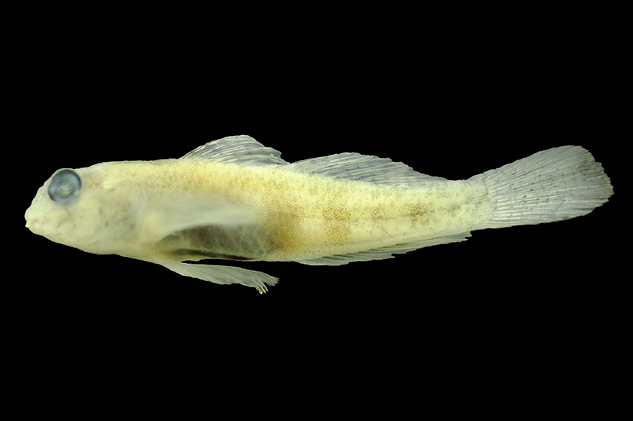Peacock Sandgoby, Gnatholepis argus Larson & Buckle 2005

Paratype of Gnatholepis argus from Turtle Reef, Field Island, Northern Territory, NTM S.14865-008. Source: Helen K. Larson / FishBase. License: All rights reserved
Summary:
A pale sandgoby with males having a row of six dusky to blackish spots or blotches along the mid-side, the rear 2-4 blackish spots darker and larger than the anterior spots and surrounded by small iridescent blue spots, and small dense black spots scattered on the unpaired fins. Females have a broken grey line along the mid-side, and indistinct dusky to blackish spots or blotches, the rear blotches not darker than the anterior ones, and no small iridescent blue spots on the body.
Cite this page as:
Bray, D.J. 2021, Gnatholepis argus in Fishes of Australia, accessed 27 Jun 2025, https://fishesofaustralia.net.au/Home/species/2227
Peacock Sandgoby, Gnatholepis argus Larson & Buckle 2005
More Info
|
Distribution |
Dampier Archipelago, Western Australia, to the Prince of Wales Island, Torres Strait, Queensland. Elsewhere the species occurs in Papua New Guinea (Daru Island). Inhabits coral and rocky reefs, in shallow intertidal pools (< 1m deep) on rocky fringing reefs, where low corals, especially faviids, and sponges are present, with a substrate of sand to muddy rock; the surrounding waters are turbid. The species may be locally abundant. |
|
Features |
Dorsal fin VI, + I, 9-11 (rarely 11); Anal fin I, 10-12; Pectoral fin 16-18; Lateral scales 24-28. Scales absent from cheek, opercle, median predorsal zone, and prepectoral area; predorsal scales absent from nape midline, scales on side of head may reach from just over opercle to nearly behind eyes; no distinct flap on end of lower lip (low fold may be present), and no distinct canine or enlarged teeth. |
|
Colour |
Males with row of six dusky to blackish spots or blotches along mid-side of body, posteriormost 3-4 blackish spots darker and larger than anterior spots and surrounded by small iridescent blue spots in life, small dense black spots scattered on unpaired fins; females with broken grey line along midside of body and dusky to blackish spots or blotches indistinct and posterior blotches not darker than anterior ones, no small iridescent blue spots on body. |
|
Similar Species |
The Peacock Sandgoby is closely related to the Nakedcheek Sandgoby, Gnatholepis gymnocara, which is restricted to the Queensland coast. Both species are small and differ from all other Gnatholepis in having a naked or mostly naked predorsal mid-line, no scales on the cheek and opercle, and all teeth in the lowerjaw are small and similar in size, with no enlarged or recurved canines. Gnatholepis argus differs from G. gymnocara in colour pattern: males being strongly marked, with small dense black spots on unpaired fins, and posterior-most 2-4 mid-lateral spots darker and larger than anterior spots (versus males without dense black spots on fins and no large dark spots on side of body in G. gymnocara). |
|
Etymology |
The species is named in reference to the Greek god Argus, of the many watchful eyes, in reference to the eye-like blue- spotted pattern along the side of the body in males. |
|
Species Citation |
Gnatholepis argus Larson & Buckle 2005, The Beagle, Records of the Museums and Art Galleries of the Northern Territory 21: 68, figs 1-5. Type locality: northern side of Turtle Reef off Field Island, Northern Territory, Australia, depth 0-0.25 m. |
|
Author |
Bray, D.J. 2021 |
|
Resources |
Peacock Sandgoby, Gnatholepis argus Larson & Buckle 2005
References
Collette, B.B. 1983. Mangrove fishes of New Guinea. pp. 91–102 in Teas, H.J. Tasks for vegetation science. The Hague : Dr. W. Jung Vol. 8 188 pp. (misidentified as Gnatholepis knighti)
Larson, H.K., Williams, R.S. & Hammer, M.P. 2013. An annotated checklist of the fishes of the Northern Territory, Australia. Zootaxa 3696(1): 1-293
Larson, H.K. & Buckle, D. 2005. A new species of the circumtropical goby genus Gnatholepis Bleeker (Teleostei: Gobiidae: Gobionellinae) from northern Australia. The Beagle, Records of the Museums and Art Galleries of the Northern Territory 21: 67-72 See ref at BHL
Larson, H.K. & Buckle, D.J. 2012. A revision of the goby genus Gnatholepis Bleeker (Teleostei, Gobiidae, Gobionellinae), with description of a new species. Zootaxa 3529: 1–69, https://doi.org/10.11646/zootaxa.3529.1.1
Randall, J.E. & Greenfield, D.W. 2001. A preliminary review of the Indo-Pacific gobiid fishes of the genus Gnatholepis. Ichthyological Bulletin of the J.L.B. Smith Institute, Grahamstown 69: 1-17 http://hdl.handle.net/10962/d1019863 (as Gnatholepis sp, and as Gnatholepis gymnocara in part - NT paratype)
Randall, J.E. & Greenfield, D.W. 2007. Redescription of Gnatholepis cauerensis (Bleeker, 1853), with discussion of the validity of the species. Zoologische Mededelingen 81(16): 303-308 See ref online
Thacker, C.E. 2004. Phylogeny and species boundaries in the gobiid genus Gnatholepis (Teleostei: Perciformes). Journal of the Linnean Society of London, Zoology 142(4): 573-582, https://doi.org/10.1111/j.1096-3642.2004.00142.x (as Gnatholepis sp.)


